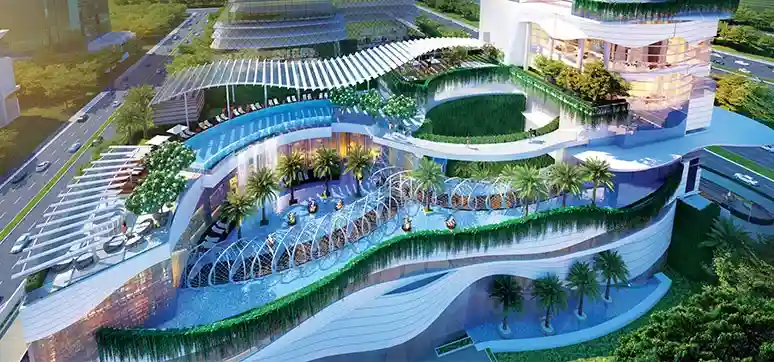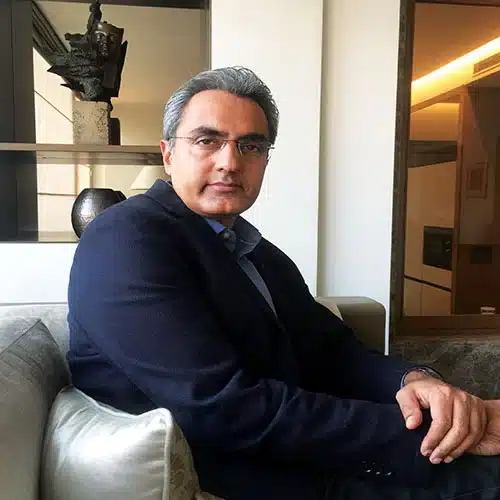Please Tell us about Your Firm Rajinder Kumar Associates (RKA)?
Our firm was established in the early 1970s by my father Rajinder Kumar, and it is regarded as one of the leading architecture, planning, landscape and interior design firms in India. We have been practicing in India and abroad for nearly five decades.
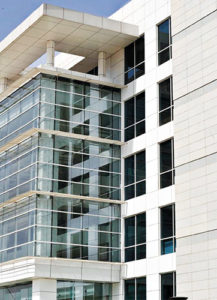
My father had practiced architecture under the able guidance of the team of Le Corbusier and Pierre Jeanerette for many years, designing several important buildings in the capital city of Chandigarh. He worked closely with these stalwarts and had a very close relationship with them.
In the late 1960s, Rajinder Kumar forayed into the tourism industry and designed tourist accommodation in the hilly areas of northern India. Five decades later RKA has contributed more to the tourism industry in India than any other architect, by designing the largest number of hotels in the country. We have designed hotels across the country, and abroad, in every category, from budget to 7-Star luxury hotels, for virtually every major hotel developer in the country and for practically every major Indian and international brand.
Designing hotels gave our firm the expertise to create a very high standard of design and detailing, exposure to international design, technology and materials that few Indian firms had. This made RKA the natural partner for many multinational corporations that entered India post liberalization in the mid- 1990s.
We got opportunities to design corporate offices for Coca- Cola, Motorola, Ericsson Microsoft, Cadence design System and ABB. I joined the firm in the early 1990s after finishing my Master of Architecture degree at the University of Pennsylvania and working in the United States for a few years. The work experience helped me to understand the design needs and aspirations of international companies setting up offices in India.
As the economy grew, major Indian corporations commissioned us to design their headquarters in India, including Maruti-Suzuki, Bharti, Reliance, Ranbaxy, Hindustan Lever and ITC. Our experience in the hospitality and corporate world helped us to eventually create one of India’s first “Platinum rated Green Building”- The ITC Green Center in Gurugram.

My experience and education of urban design helped us to handle large and complex projects and create large campus designs for major technology companies such as HCL technology, Tech Mahindra, NIIT, Ascendas (Singapore) and many leading real estate developers.
Alongside these large campuses, we got opportunities to design housing complexes for major developers in the north and central India. One of our design studios continues to create distinctive designs for housing in all segments across India in cities like Gurgaon, Noida, Kolkata, Lucknow, Nagpur, Bengaluru and Mohali.
In the last 10 years, we extended our hospitality skills to create two of India’s most talked about specialty hospitals; The Fortis Memorial at Gurgaon and the recently launched Apollo Proton Care Cancer Center at Chennai.
Today, our work spans across all parts of India and abroad with designs in cities like Bengaluru, Chennai, Kolkata, Mumbai, Trivandrum, Kochi, Mysore, Pune, Guwahati, Raipur, Ranchi, New Delhi, Noida and Gurgaon. Overseas, we have successfully completed projects in Muscat (Oman), the Philippines, London, Sunnyvale (California), Doha and Bhutan.
You have been in the Industry for the Past 25 Years. How the Façade industry has changed over the years?
We have seen a tremendous change in the façade industry over these 25 years. Our firm’s early works in the 1970-80s were largely masonry buildings using brick and natural stones of India.
In the early 1990s, it was the first time one moved away from masonry façades and started getting technologies like curtain walls, aluminium claddings, glass and metal claddings, etc. We combined these new technologies with traditional Indian materials in a very contemporary manner that made our façades unique and appealing to many of India’s best developers and corporations.

We became one of the pioneers in Green building design in India with the project “The ITC Green Centre,”built in 2003, declared as first platinum-rated green building in India. Because of the awareness on green and sustainable designs, suddenly there came to a new shift again in the last decade, where one started looking at limited use of glass and all that one learned from traditional architecture started to come back using modern technologies for design and construction.
Of course, today’s challenge is meeting the aspirations of developers and clients to create façades that are international in character but still work in the Indian context.
Could you Please tell us about Some of your Projects and the Materials that you use in your Façade Designs?
One of the things that our firm takes pride in is to design façades that can use any kind of material. We are not bound with the use of a specific kind of material, and we want our every building to appear different. We use all kinds of materials – from brick to stone, glass, plaster, aluminium, metal and a combination of new and traditional materials using various technologies.

Each project is made to suit a particular budget and scale. In the `1980s and 90s, we did a lot of hospitality projects with natural stones, and recently we have done 4-5 projects with plaster and very limited use of glass. The choice of material depends on that particular project location, budget and climatic response.
We are comfortable in using any number of materials, but we try to get sustainability, longevity and are particular that the design should bring the desired impact, which is mandated by the client.
Could you Please tell us about Some of your Recent Projects in which you have used a Special Kind of Façade?
Recently, we have finished the design for the Indian Institute of Management in Nagpur. For this project, we are using a very special terracotta tile façade, which forms the major exterior, along with a kind of plastic concrete finish plaster.

This modern technology of using terracotta façade along with the little bit of curtain wall and a system of louvers made of aluminium is going to create a very special appearance. It will give all the benefits of natural ventilation and will also protect from the strong sun. It was the one project where we were excited to provide a sustainable environment without overspending on-air-conditioning in an educational institution (air conditioning is a big energy guzzler in educational institutions).
While designing institutes like this one, one needs to plan such that they will function seamlessly for decades. We are trying many techniques of natural ventilation like openable windows, louvers, varied window positions and the optimum sizing of windows for different functions of the institute. Large shading roofs with solar panels make interesting university walks and shade the building façade on both sides.

What is the Role of Façade Consultants?
When we started doing buildings with the external skin and curtain walls, we did not have the option for specialized façade consultants for that. We, as a firm, had to educate ourselves, do lots of research, visit world-class buildings, study good technologies, manufacturing plants and projects all over the world, and train our own team to have that expertise.

The kind of level of skills that we have to detail external skin on buildings is sometimes far more than expected from most architectural firms. Nowadays, there are specialized consultants who have worked on special projects with us, and for most others, we still ourselves do the detailing of them.
It is essential for any top quality project to have a team of experts. For special projects and high-rise buildings, we have worked with a lot of groups in India and overseas who have expertise in façade engineering. Façade consultants help the architects realise their vision of expressing the façades while giving the users a safe and comfortable environment inside the building.
What are the Things to Consider while Designing Façade of a High Rise Building?
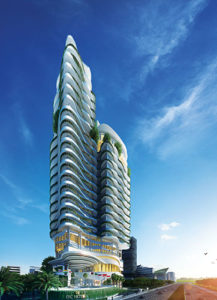
The intent of the façade comes from the architectural team in terms of what their expression would be. Just because of their height, tall buildings become the landmark or monumental in their appearance. One has to be careful about how to make these buildings look lighter. The key factors to be looked upon while designing high-rise buildings are the behavior of buildings at certain heights considering the wind loads, its impact on the external skins, and the structural challenges of going that high.
Application or installation of cladding materials faces many challenges above certain heights and the cost involved also increases with heights. We believe in using the most efficient trends in India and often collaborate with contractors to understand their challenges of buildings of certain heights and we capture them in façade designs. In the end, the design should be buildable in India using locally available techniques and equipment.
The requirements of the builders are changing day by day, as they want the iconic buildings.How do you Cope up with their Demands Through your Designs?

The desire to create iconic buildings must be matched with appropriate budgets and the will to use the best technologies and agencies to create them. Many cities in India attempt to ape iconic buildings overseas that turn out to be very poor cousins of the originals. We use our best skills to create very high standards of design that are unique using technology and budgets available for projects in India.
It is not uncommon to see iconic projects finish in a very different manner as the design of the façade gets cut or changed during the execution stage.
Tell us About the Major Projects you have Done or Currently Doing.

We have done a number of campus designs for technology companies and developers in India, like the 50-acre campus for HCL Technology in Noida. The façades of this project use a combination of metal, and stone combined with a unique landscape gave a wonderful campus design.
HCL also gave us the opportunity to design a 100-acre campus in Lucknow where we had to create a campus atmosphere within a much-reduced budget. We are very happy that we have created the first couple of phases for this project using a lot less glass, along with metal and texture paint, with smaller windows and openings.
These are business buildings which needed to be done within a very short period of time. The technology of external skins, structures, the kind of glass and panelling system had to be designed and built very fast. In fact, one of the buildings is completely prefabricated using steel technology and was built in a six-month period. Most of these kind of campuses are using extensive green technology today.
We make sure that the buildings get a lot of natural light. Almost all these spaces are naturally lit to help in reducing the lighting loads of these buildings.
You have been Doing Projects in different Cities with different Weather Conditions. How do you Approach the Ventilation of the Building or How do you Plan the Design?
We first do a deep study on the climatic conditions of the city. We arrange sessions with the users and get to know the details of the climatic conditions of that particular city. This is the technique we are currently using for our projects – University projects in Nagpur and Mohali where temperatures get very high.
Hostel buildings typically have a central corridor with rooms on both sides for higher planning efficiency but often it gets monotonous. Here we have introduced breaks in façades that allow natural ventilation. It gives the opportunity to open up the windows and allow natural ventilation in the corridors. We are using this technique effectively in several designs of educational institutions.
Tell us About the Software you use in your Projects.
We use the latest CAD & REVIT technology as we model our projects. The architectural software is accompanied by tools of sustainability experts who help us in almost every step of any project using additional software. For almost all our projects, we use the best software to model the buildings and understand how they behave in a different manner and in different conditions. There are many materials available in the market like aluminium PVC etc.
How do you Incorporate the Material for Fenestration?

For the architects who prefer aluminium, (who are used to a particular material) for windows, it is usually tough for them to switch to other materials. But, we do experiments with new materials all the time on ourselves. We try out these materials in our own homes/offices in smaller projects. Currently, we are using PVC windows in a number of projects, after experimenting and testing them in smaller projects.
This has helped us a lot, and now we are using PVC extensively in large housing projects with variations to get different finishes. We are using the best technologies in both aluminium and PVC in most of our projects.
Can an Architect Specify Materials for Fire Safety?
We take this subject very seriously in our firm. Our hospitality projects always demand the highest standards of life & fire safety. We extend this learning and expertise on all types of building projects. We do training and workshops in our design studio and ensure that senior design professionals look at every component in buildings.

We take extra protection when we do skin detailing of façades to make sure that if in any event the first level fails, there is always an option of second level protection. Our firm always works with the best life and safety consultants in India and abroad.
What Advice would you like to give to the Youngsters?
In India, a 5-year degree gives one a license to practice through the practical knowledge at that stage is limited. I feel that there should be a compulsory period of working in a firm for a few years before young architects get this license to use. My suggestion would be that the young architects should work with firms for a certain period of time.
In firms, you can experience a variety of project cycles done from the concept to the end in a relatively short period. The technology, science and the expectations are so advanced now that unless you have gone through the cycle, you cannot truly understand the building design and construction process.
IIM – Nagpur

Located in Mihan, Nagpur, this 132acre project is planned to be developed in phases – Phase 1 of the Griha 4-Star rated green campus will be developed on 66 acres. This smart campus will include academic buildings, student hostels, libraries, dining facilities, administration block, faculty blocks, guest houses, sports center, health center, visitor centers and an amphitheater.
All structures have been designed around meaningfully landscaped and ecologically green spaces such as cycle tracks, pedestrian friendly pathways and plazas offering students a safe & comfortable environment, one that caters towards spontaneous interactions and promotes a sense of community.
QUICK FACTS:
Project: Indian Institute of Management (IIM) Campus
Location: Nagpur, India
Client: IIM Nagpur /EIL
Architect: Rahul Kumar
Other consultants: Denfab Consultants, Gupta Consultants.
Integral Designs Materials used for Facade & Fenestration: Terracotta tiles, Double Glass Unit (DGU) glass, ACP, and metallic paint
Commencement Date: September 2018
Tech Mahindra Campus, Pune

This campus for Tech Mahindra was designed on a plot of size 24 acres and the total built up area comprised of 1.8 million sq. ft. The project was designed & executed in phases. This campus consists of a corporate block, software blocks, training blocks and other recreational facilities.
Quick Facts:
Project: Tech Mahindra Campus
Location: Hinjewadi, Pune
Client: Tech Mahindra Ltd.
Architect: Rajinder Kumar
Other consultants: JW Consultants LLP, RS Kulkarni, Ace Consultants, Abhiyanta Electricals
Materials used for Facade & Fenestration: Granite stone cladding, Texture paint, Double Glass Unit (DGU) glass, and ACP at the porch
Commencement Date: November 2006
Completion Date: September 2013
PNB Corporate Office, New Delhi

Following an intense design competition, RKA was selected by Punjab National Bank (PNB) and CPWD to design the PNB Corporate Office, their headquarters, at Dwarka, New Delhi.
The project was spread over 4.8 acres, comprised 8,25,000 square feet and was a dream project of the entire PNB Staff and Management. CPWD managed the project on behalf of PNB and RKA provided all-inclusive services for the project, including master planning, architectural, structural, interior design and engineering services.
Quick Facts:
Project: PNB Corporate Office
Location: Sector 10, Dwarka, New Delhi
Client: Punjab National Bank /CPWD
Architect: Rahul Kumar
Other Consultants: TPC Technical Projects Consultants, Ener Save Consultants, Environmental Design Solutions, Integral Design
Materials used for Facade & Fenestration: 35mm Granite stone – Natural Gold, Double Glass Unit (DGU) glass, and ACP – metallic silver
Commencement Date: October 2011
Completion Date: October 2018
Bharti Airtel and Maruti Suzuki Corporate Offices, New Delhi

RKA was selected by Bharti Televentures and Maruti-Suzuki jointly to design their corporate offices at the prestigious Vasant Kunj shopping mall area in New Delhi.
The project consisted of offices for both the companies to be built on a single site with an area of about 14,820 Sq m, to have a built-up area of 6,00,000 Sq ft. spread across 7 Floors. The overall semi-circular form of the one building respected the master planning guidelines and yet provided completely independent office spaces to both the users.
Roof gardens at the top level are attached to executive areas and a Japanese hotel. The façade of high performance glass, aluminium and granite portray the hi-tech nature of both the companies’ businesses. RKA provided comprehensive services for the projects, including master planning, architectural, structural, interior design and engineering services.
Quick Facts:
Project: Bharti Airtel and Maruti Suzuki Corporate Offices
Location: Vasant Kunj, New Delhi
Client: Bharti Airtel and Maruti Suzuki Ltd.
Architect: Rajinder Kumar, Rahul Kumar
Other Consultants: Semac Pvt Ltd., Kanwar Krishen & Associates, Spectral Services Consultants Pvt. Ltd., Deolalikar Consultants, Design Cell
Materials used for facade & fenestration: Aluminium composite panel, granite, and a high performance glass curtain wall.
Commencement date: October 2004
Completion date: September 2008
Ibis Kolkata, Rajarhat
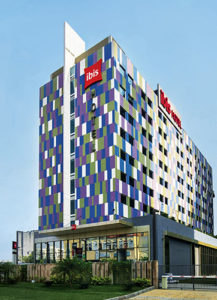
The Hotel, Ibis Kolkata is strategically located on the major arterial road of Rajarhat, New Town in Kolkata. Its design is inspired by the rich and vibrant heritage and culture of West Bengal. Numerous local elements are depicted through artworks of hand-pulled rickshaws, Howrah bridge, trams and more. The lobby is inspired by Bengal’s famous kantha design and embroidery.
InterGlobe Hotels in partnership with AccorHotels launched this hotel in January 2019. The façade is designed to depict the young, modern and colourful side of Kolkata which is simple yet appealing. The bright and exciting colours in the pixelated pattern along with the modern styled windows give the impression of a contemporary style building.
A unique design feature is that the building massing and design was accomplished by using advanced energy modelling software that tracks the sun path movement. Detailed shadow analysis was done, which helped in windows design and accordingly shading features were used. Even the materials used in the building façade like high-performance glass, plaster, aluminium glazing, aluminium louvres, uPVC windows ensure energy efficiency at the property.

The hotel features an assortment of beautifully designed landscaped roofs The hotel has 189 comfortable & well-designed guest rooms. All the guest rooms present a panoramic view of the city. The public spaces are open, vibrant and are designed with purposeful environments.
It is a next-generation hotel that features urban-influenced design, accessible technology, style and a social atmosphere to enhance experiences and keep pace with the new age visitors.
The overall architectural elaboration embarks on its own unique identity and makes the building design differentiator in the neighbourhood. The design augments value for the customers and provides an experience that is original and stimulating.
QUICK FACTS:
Project: Ibis Kolkata
Location: Rajarhat, New Town, Kolkata
Client: InterGlobe Hotels in partnership with AccorHotels
Architect: Ar. Rajinder Kumar & Ar. Rahul Kumar, RKA
